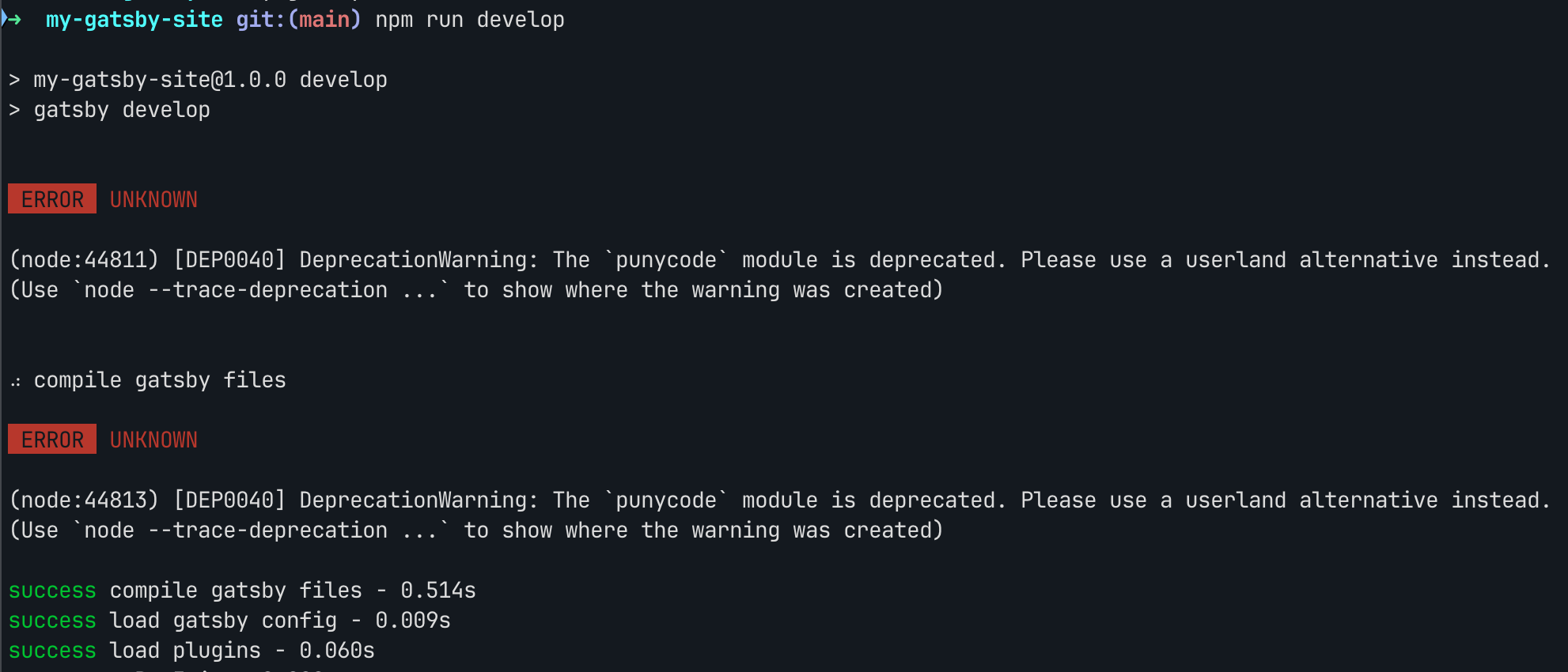
Following on from the previous post about static site generators, the next one I took for a spin was Gatsby.
Installing via npm init gatsby is a great experience. This will automatically download the create-gatsby package and executed it, meaning there’s no need to install anything prior to development, other than node and npm. This init script guides us through a terminal user interface (TUI) to select various options, such as project name, whether we want to use a CMS, and some optional plugins we might want to enable. It finishes by suggesting we run npm run develop to launch our newly created site.
And that’s where the wheels come off a little bit. I’m running node version 22.11.0, and the first run gives an error:

Apparently, the solution is to downgrade node to version 20, but this workaround won’t last forever, and the bug was first reported a year ago. Node 22 is the current LTS release, so having to downgrade is disappointing. I feel it’s not a great first run experience, but it appears the “error” is benign (which begs the question, why not a warning?) I also appreciate that this is a transitive dependency that Gatsby takes, so it might not be in their hands to fix … I didn’t have time to dig into whether Gatsby’s direct dependencies have been patched to fix this. But overall, I think that if a user is running the current LTS and encounters this, it should be at least called out in a fairly obvious way on the Gatsby quick start guide.
UPDATE - after writing the above, based on my use of Gatsby’s quick start, I took a look at the full tutorial; section 0 does say that the requirements are for Node.js (v18 or newer, but less than v21). Still disappointing, but less so. I feel this should be more prominently called out, including on the quick start guide. Further down the section 0 page, it says to install node with brew install node which would not meet the requirements … at the time of writing, this will install Node v24. It likely should say to use brew install node@20.
The getting started guide then took me into writing .js pages to show pages. This is a much steeper learning curve than just dropping Markdown files in a directory like with Hugo. For example, to create an About page, the code below is suggested as a starting point and should be saved at src/pages/about.js:
// Step 1: Import React
import * as React from 'react'
// Step 2: Define your component
const AboutPage = () => {
return (
<main>
<h1>About me</h1>
<p>Hi there! I'm Richard.</p>
</main>
)
}
export const Head = () => <title>About Me</title>
// Step 3: Export your component
export default AboutPage
The about page can then be found under /about in the generated site.
Layouts can be implemented too, e.g.:
import * as React from 'react'
import { Link } from 'gatsby'
const Layout = ({ pageTitle, children }) => {
return (
<div>
<Link to="/">Home</Link>
<hr/>
<h1>{pageTitle}</h1>
{children}
</div>
)
}
export default Layout
And then referencing it in the about page like this:
import * as React from 'react'
import Layout from '../components/layout'
const AboutPage = () => {
return (
<Layout pageTitle="About Me">
<p>Hi there! I'm Richard.</p>
</Layout>
)
}
Just like with Hugo, there are pre-written GitHub Actions for deploying a Gatsby site to GitHub Pages, and it works great.
In short, you can use GitHub Actions to run npm run build which generates the static content for your site in the ./public directory, and then deploy that to GitHub Pages using the peaceiris/actions-gh-pages@v4 GitHub Action.
Something like this will do the trick, in .github/workflows/gatsby.yml:
name: Deploy Gatsby site to GitHub Pages
on:
push:
branches: [main]
jobs:
build-and-deploy:
runs-on: ubuntu-latest
steps:
- name: Checkout
uses: actions/checkout@v4
- name: Setup Node.js
uses: actions/setup-node@v4
with:
node-version: '20'
- name: Install dependencies
run: npm install
- name: Build Gatsby site
run: npm run build
- name: Deploy to GitHub Pages
uses: peaceiris/actions-gh-pages@v4
with:
github_token: $
publish_dir: ./public
Now, the Gatsby documentation doesn’t seem to mention any hosting providers other than using Netlify, but as I say, you can host it anywhere you want. Since Netlify’s acquisition of Gatsby in 2023, they seem to be strongly pushing Netlify as the place to host your Gatsby sites.
Sometimes, the node ecosystem can lead to bloated disk space usage due to the number of packages downloaded to node_modules. Unfortunately, Gatsby is no exception to this, with my hello world example site weighing in at 629 MB, of which 567 MB is contained in the node_modules directory. Compare this with my hello world Hugo site from the previous post, which totals just 12 MB. For some with relatively modest storage capacity, this could be a real consideration when deciding which static site generator to use.
Gatsby feels super powerful, but users without a decent grounding in React might find the learning curve to be pretty steep. In terms of its use for hosting a simple blog, it’s likely overkill, particularly for the kind of thing I’d want to do.